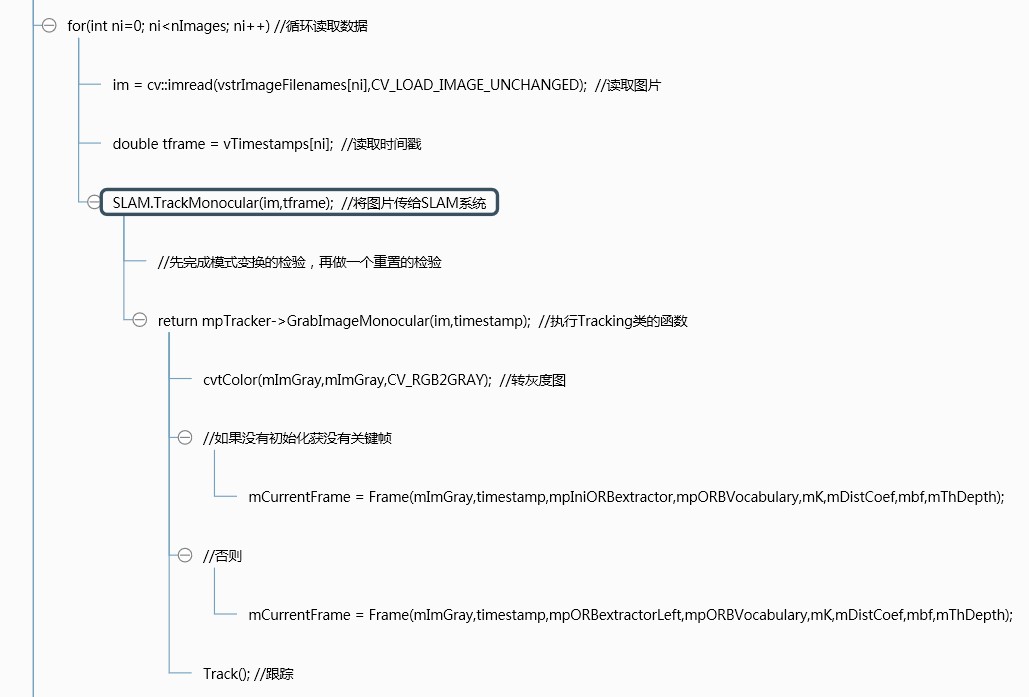1. Tracking框架
Tracking线程流程框图:

各流程对应的主要函数
2. Tracking整体流程图

上面这张图把Tracking.cc讲的特别明白。
tracking线程在获取图像数据后,会传给函数GrabImageStereo、GrabImageRGBD或GrabImageMonocular进行预处理,这里以GrabImageMonocular为例。
GrabImageMonocular(const cv::Mat &im, const double ×tamp)
| 函数功能 | 1. 将图像转为mImGray并初始化mCurrentFrame; 2. 进行tracking过程,输出世界坐标系到该帧相机坐标系的变换矩阵 |
| im | 输入图像 |
| timestamp | 时间戳 |
cv::Mat Tracking::GrabImageMonocular(const cv::Mat &im, const double ×tamp){mImGray = im;//读取图像// 步骤1:将RGB或RGBA图像转为灰度图像if(mImGray.channels()==3){if(mbRGB)cvtColor(mImGray,mImGray,CV_RGB2GRAY);elsecvtColor(mImGray,mImGray,CV_BGR2GRAY);}else if(mImGray.channels()==4){if(mbRGB)cvtColor(mImGray,mImGray,CV_RGBA2GRAY);elsecvtColor(mImGray,mImGray,CV_BGRA2GRAY);}// 步骤2:构造Frameif(mState==NOT_INITIALIZED || mState==NO_IMAGES_YET)// 没有成功初始化的前一个状态就是NO_IMAGES_YETmCurrentFrame = Frame(mImGray,timestamp,mpIniORBextractor,mpORBVocabulary,mK,mDistCoef,mbf,mThDepth);elsemCurrentFrame = Frame(mImGray,timestamp,mpORBextractorLeft,mpORBVocabulary,mK,mDistCoef,mbf,mThDepth);// 步骤3:跟踪Track();return mCurrentFrame.mTcw.clone();
}数据,流到Track(),由于代码超长,分几段粘贴注释。
void Tracking::Track()
| 步骤 | 1. 判断tracking状态:如果是未初始化(NOT_INITIALIZED),则对单目和非单目分别执行MonocularInitialization()、StereoInitialization()进行初始化,并更新地图视图。 2.对于初始化成功的,接下来进行跟踪ORB-SLAM中关于跟踪状态有两种选择(由mbOnlyTracking判断) (1)只进行跟踪不建图 (2)同时跟踪和建图: 初始化之后ORB-SLAM有三种跟踪模型可供选择 a.TrackWithMotionModel(); 运动模型:根据运动模型估计当前帧位姿——根据匀速运动模型对上一帧的地图点进行跟踪——优化位姿。 b.TrackReferenceKeyFrame(); 关键帧模型:BoW搜索当前帧与参考帧的匹配点——将上一帧的位姿作为当前帧的初始值——通过优化3D-2D的重投影误差来获得位姿。 c.Relocalization();重定位模型:计算当前帧的BoW——检测满足重定位条件的候选帧——通过BoW搜索当前帧与候选帧的匹配点——大于15个点就进行PnP位姿估计——优化。 这三个模型的选择方法: 首先假设相机恒速(即Rt和上一帧相同),然后计算匹配点数(如果匹配足够多则认为跟踪成功),如果匹配点数目较少,说明恒速模型失效,则选择参考帧模型(即特征匹配,PnP求解),如果参考帧模型同样不能进行跟踪,说明两帧键没有相关性,这时需要进行重定位,即和已经产生的关键帧中进行匹配(看看是否到了之前已经到过的地方)确定相机位姿,如果重定位仍然不能成功,则说明跟踪彻底丢失,要么等待相机回转,要不进行重置。 |
2.1. 初始化部分
void Tracking::Track()
{// track包含两部分:估计运动、跟踪局部地图// mState为tracking的状态// SYSTME_NOT_READY, NO_IMAGE_YET, NOT_INITIALIZED, OK, LOST// 如果图像复位过、或者第一次运行,则为NO_IMAGE_YET状态if(mState==NO_IMAGES_YET){mState = NOT_INITIALIZED;}// mLastProcessedState存储了Tracking最新的状态,用于FrameDrawer中的绘制mLastProcessedState=mState;// Get Map Mutex -> Map cannot be changedunique_lock<mutex> lock(mpMap->mMutexMapUpdate);// 步骤1:初始化if(mState==NOT_INITIALIZED)//判断是否初始化{if(mSensor==System::STEREO || mSensor==System::RGBD)//双目或深度相机StereoInitialization();//双目初始化elseMonocularInitialization();//单目初始化mpFrameDrawer->Update(this);if(mState!=OK)return;}
}2.3. 跟踪
2.3.1. 跟踪上一帧或者参考帧或者重定位
else// 步骤2:跟踪{// System is initialized. Track Frame.系统完成初始化,跟踪帧// bOK为临时变量,用于表示每个函数是否执行成功bool bOK;// Initial camera pose estimation using motion model or relocalization (if tracking is lost)运用运动模型或重定位初始化相机位姿估计// 在viewer中有个开关menuLocalizationMode,有它控制是否ActivateLocalizationMode,并最终管控mbOnlyTracking// mbOnlyTracking等于false表示正常VO模式(有地图更新),mbOnlyTracking等于true表示用户手动选择定位模式if(!mbOnlyTracking){// Local Mapping is activated. This is the normal behaviour, unless// you explicitly activate the "only tracking" mode.// 正常初始化成功if(mState==OK){// Local Mapping might have changed some MapPoints tracked in last frame// 检查并更新上一帧被替换的MapPoints// 更新Fuse函数和SearchAndFuse函数替换的MapPointsCheckReplacedInLastFrame();// 步骤2.1:跟踪上一帧或者参考帧或者重定位// 运动模型是空的或刚完成重定位// mCurrentFrame.mnId<mnLastRelocFrameId+2表示刚重定位少于两帧// 应该只要mVelocity不为空,就优先选择TrackWithMotionModel// mnLastRelocFrameId上一次重定位的那一帧if(mVelocity.empty() || mCurrentFrame.mnId<mnLastRelocFrameId+2){// 将上一帧的位姿作为当前帧的初始位姿// 通过BoW的方式在参考帧中找当前帧特征点的匹配点// 优化每个特征点都对应3D点重投影误差即可得到位姿bOK = TrackReferenceKeyFrame();//跟踪参考帧}else{// 根据恒速模型设定当前帧的初始位姿// 通过投影的方式在参考帧中找当前帧特征点的匹配点// 优化每个特征点所对应3D点的投影误差即可得到位姿bOK = TrackWithMotionModel();//根据固定运动速度模型预测当前帧的位姿if(!bOK)// TrackReferenceKeyFrame是跟踪参考帧,不能根据固定运动速度模型预测当前帧的位姿态,通过bow加速匹配(SearchByBow)// 最后通过优化得到优化后的位姿bOK = TrackReferenceKeyFrame();}}else{// BOW搜索,PnP求解位姿bOK = Relocalization()//重定位成功与否}}else{// Localization Mode: Local Mapping is deactivated// 只进行跟踪tracking,局部地图不工作// 步骤2.1:跟踪上一帧或者参考帧或者重定位// tracking跟丢了if(mState==LOST){ bOK = Relocalization();//判断重定位成功与否标志}else{// mbVO是mbOnlyTracking为true时的才有的一个变量// mbVO为false表示此帧匹配了很多的MapPoints,跟踪很正常,// mbVO为true表明此帧匹配了很少的MapPoints,少于10个,要跪的节奏if(!mbVO){// In last frame we tracked enough MapPoints in the map// mbVO为0则表明此帧匹配了很多的3D map点,非常好if(!mVelocity.empty()){bOK = TrackWithMotionModel();}else{bOK = TrackReferenceKeyFrame();}}else{// In last frame we tracked mainly "visual odometry" points.在上一帧我们主要跟踪视觉里程计点// We compute two camera poses, one from motion model and one doing relocalization.我们由运动模型和重定位计算相机位姿// If relocalization is sucessfull we choose that solution, otherwise we retain// the "visual odometry" solution.// mbVO为1,则表明此帧匹配了很少的3D map点,少于10个,要跪的节奏,既做跟踪又做定位bool bOKMM = false;//运动模型是否成功判断标志bool bOKReloc = false;//重定位是否成功判断标志vector<MapPoint*> vpMPsMM;//记录地图点vector<bool> vbOutMM;//记录外点cv::Mat TcwMM;//变换矩阵if(!mVelocity.empty())//有速度{bOKMM = TrackWithMotionModel();//用运动模型追踪vpMPsMM = mCurrentFrame.mvpMapPoints;//记录地图点vbOutMM = mCurrentFrame.mvbOutlier;//记录外点TcwMM = mCurrentFrame.mTcw.clone();//当前帧的变换矩阵}bOKReloc = Relocalization();//用重定位// 重定位没有成功,但是运动模型跟踪成功if(bOKMM && !bOKReloc){mCurrentFrame.SetPose(TcwMM);mCurrentFrame.mvpMapPoints = vpMPsMM;mCurrentFrame.mvbOutlier = vbOutMM;if(mbVO){// 更新当前帧的MapPoints被观测程度for(int i =0; i<mCurrentFrame.N; i++){if(mCurrentFrame.mvpMapPoints[i] && !mCurrentFrame.mvbOutlier[i]){mCurrentFrame.mvpMapPoints[i]->IncreaseFound();}}}}else if(bOKReloc)// 只要重定位成功整个跟踪过程正常进行(定位与跟踪,更相信重定位){mbVO = false;}bOK = bOKReloc || bOKMM;}}}2.3.2. local map跟踪
在帧间匹配得到初始的姿态后,现在对local map进行跟踪得到更多的匹配,并优化当前位姿,local map:当前帧、当前帧的MapPoints、当前关键帧与其它关键帧共视关系,在上一步中主要是两两跟踪(恒速模型跟踪上一帧、跟踪参考帧),这里搜索局部关键帧后搜集所有局部MapPoints,然后将局部MapPoints和当前帧进行投影匹配,得到更多匹配的MapPoints后进行Pose优化。
2.4. 速度模型
更新恒速运动模型TrackWithMotionModel中的mVelocity
// 将最新的关键帧作为reference frame,接上面代码mCurrentFrame.mpReferenceKF = mpReferenceKF;if(!mbOnlyTracking){if(bOK)bOK = TrackLocalMap();}else{// mbVO true means that there are few matches to MapPoints in the map. We cannot retrieve// a local map and therefore we do not perform TrackLocalMap(). Once the system relocalizes// the camera we will use the local map again.// 重定位成功if(bOK && !mbVO)bOK = TrackLocalMap();}if(bOK)mState = OK;elsemState=LOST;// Update drawermpFrameDrawer->Update(this);// If tracking were good, check if we insert a keyframeif(bOK){// Update motion modelif(!mLastFrame.mTcw.empty()){// 步骤2.3:更新恒速运动模型TrackWithMotionModel中的mVelocitycv::Mat LastTwc = cv::Mat::eye(4,4,CV_32F);mLastFrame.GetRotationInverse().copyTo(LastTwc.rowRange(0,3).colRange(0,3));mLastFrame.GetCameraCenter().copyTo(LastTwc.rowRange(0,3).col(3));mVelocity = mCurrentFrame.mTcw*LastTwc; // 其实就是Tcl} elsemVelocity = cv::Mat();mpMapDrawer->SetCurrentCameraPose(mCurrentFrame.mTcw);2.4.1. 清除UpdateLastFrame中为当前帧临时添加的MapPoints
清除临时的MapPoints,这些MapPoints在TrackWithMotionModel的UpdateLastFrame函数里生成(仅双目和rgbd)
检测并插入关键帧,对于双目会产生新的MapPoints
// 步骤2.4:清除UpdateLastFrame中为当前帧临时添加的MapPointsfor(int i=0; i<mCurrentFrame.N; i++)//遍历当前帧所有MapPoint{MapPoint* pMP = mCurrentFrame.mvpMapPoints[i];if(pMP)// 排除UpdateLastFrame函数中为了跟踪增加的MapPointsif(pMP->Observations()<1){mCurrentFrame.mvbOutlier[i] = false;mCurrentFrame.mvpMapPoints[i]=static_cast<MapPoint*>(NULL);}}// Delete temporal MapPoints// 步骤2.5:清除临时的MapPoints,这些MapPoints在TrackWithMotionModel的UpdateLastFrame函数里生成(仅双目和rgbd)// 步骤2.4中只是在当前帧中将这些MapPoints剔除,这里从MapPoints数据库中删除// 这里生成的仅仅是为了提高双目或rgbd摄像头的帧间跟踪效果,用完以后就扔了,没有添加到地图中for(list<MapPoint*>::iterator lit = mlpTemporalPoints.begin(), lend = mlpTemporalPoints.end(); lit!=lend; lit++){MapPoint* pMP = *lit;delete pMP;}// 这里不仅仅是清除mlpTemporalPoints,通过delete pMP还删除了指针指向的MapPointmlpTemporalPoints.clear();// Check if we need to insert a new keyframe// 步骤2.6:检测并插入关键帧,对于双目会产生新的MapPointsif(NeedNewKeyFrame())CreateNewKeyFrame();// We allow points with high innovation (considererd outliers by the Huber Function)我们允许具有高创新点(考虑胡贝尔函数的异常值)// pass to the new keyframe, so that bundle adjustment will finally decide传递到新的关键帧,这样束调整将最终决定// if they are outliers or not. We don't want next frame to estimate its position如果它们是外点。我们不希望下一帧估计它的位置。// with those points so we discard them in the frame.// 删除那些在bundle adjustment中检测为outlier的3D map点for(int i=0; i<mCurrentFrame.N;i++){if(mCurrentFrame.mvpMapPoints[i] && mCurrentFrame.mvbOutlier[i])mCurrentFrame.mvpMapPoints[i]=static_cast<MapPoint*>(NULL);}}// Reset if the camera get lost soon after initialization// 跟踪失败,并且relocation也没有搞定,只能重新Resetif(mState==LOST){if(mpMap->KeyFramesInMap()<=5){cout << "Track lost soon after initialisation, reseting..." << endl;mpSystem->Reset();return;}}if(!mCurrentFrame.mpReferenceKF)mCurrentFrame.mpReferenceKF = mpReferenceKF;// 保存上一帧的数据mLastFrame = Frame(mCurrentFrame);}2.5. 记录位姿信息,用于轨迹复现
if(!mCurrentFrame.mTcw.empty()){// 计算相对姿态T_currentFrame_referenceKeyFramecv::Mat Tcr = mCurrentFrame.mTcw*mCurrentFrame.mpReferenceKF->GetPoseInverse();mlRelativeFramePoses.push_back(Tcr);mlpReferences.push_back(mpReferenceKF);mlFrameTimes.push_back(mCurrentFrame.mTimeStamp);mlbLost.push_back(mState==LOST);}else{// This can happen if tracking is lost// 如果跟踪失败,则相对位姿使用上一次值mlRelativeFramePoses.push_back(mlRelativeFramePoses.back());mlpReferences.push_back(mlpReferences.back());mlFrameTimes.push_back(mlFrameTimes.back());mlbLost.push_back(mState==LOST);}
}参考文献
主要内容来自下文,注释略有增改
ORB-SLAM2从理论到代码实现(六):Tracking.cc程序详解(上)_track lost soon after initialisation, reseting...-CSDN博客





![[Android]联系人-删除修改](http://pic.xiahunao.cn/[Android]联系人-删除修改)



)
)
)









